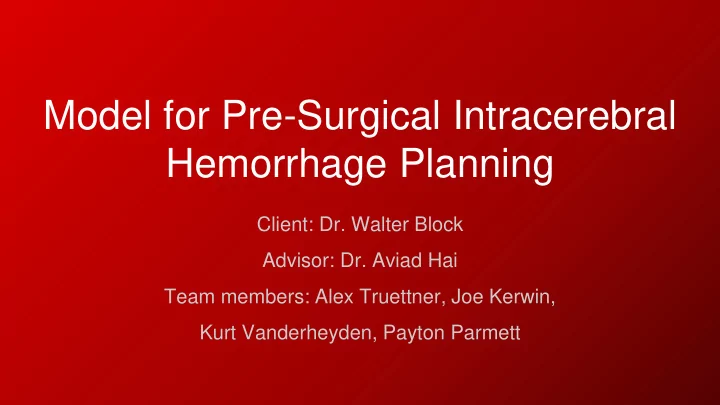

Model for Pre-Surgical Intracerebral Hemorrhage Planning Client: Dr. Walter Block Advisor: Dr. Aviad Hai Team members: Alex Truettner, Joe Kerwin, Kurt Vanderheyden, Payton Parmett
Overview ● Problem Statement ● Background and Prior Work ● PDS ● Design Alternatives ● Design Matrix ● Future Work: Stages 1-4 ● References ● Acknowledgements
Problem Statement ● In the past, very little could be done for patients with intracerebral hemorrhaging ● Recent efforts being made to remove as much clot as possible to prevent damage ● Characteristics of different clots vary - differences in rigidity affect removal approach ● Research being done to map rigidity of clots before operation Goal is to create a gel model to simulate interior of brain with various clots to image and validate the effectiveness of mapping techniques
Background / Prior Work ● Recently two methods to remove cerebral clots have been developed ● The method used is dependent upon the stiffness of the clots ○ Suction ○ Drug treatment then suction ● A phantom brain is needed to acquire a range of stiffness measurements to be used in a database ● The phantom will also be used to test MRI Resolution ● Last semester T1 and T2 imaging results from last semester ○ Gel making protocol ○ Proof of concept completed
PDS - Final stiffness should be comparable to brain matter Size of “Clots” must test the accuracy of MRI - - Must be resilient to handling and transport - The phantom must be able to handle powerful magnetic fields (no metal) - Must be sharp contrast between stiffnesses
Updated Design
Gel Fabrication Protocol Protocol: 1. Dissolve alginate in warm water 2. Add CaCO 3 and Glucono- δ -lactone 3. Mix gel thoroughly 4. Before the gel sets, scoop it into the finger-tip of a latex glove 5. Tie the top of the latex glove off, ensuring no air gets in the glove 6. Allow the clot gel to set in a fridge 7. Repeat steps 1-4 for gel iterations 8. Suspend the clot using a wooden stick in the cavity of the container 9. Pour the base gel into the cavity and allow the gel to set in the fridge
Future Work - Stage One ● All alginate gel besides outer plastic shell ● “Brain” base gel ● “Clot” gels of varying rigidity ● Prevent air-gel interface with “clots” ● Same size “clots”
Future Work - Stage Two ● Same setup as stage two ● Refined range of varying “clot” rigidity ● Goal is to find imaging threshold
Future Work - Stage Three ● Same setup as previous stages ● One “clot” rigidity - whatever was found to be threshold in stage two ● “Clots” of varying sizes ● Testing for smallest detectable “clot”
Future Work - Stage Four ● New sample holder - brain model ● Same constant threshold “clot” rigidity ● Different “brain” gels to model gray and white matter ○ Different depths of clots ○ Different sizes of clots https://onlinelibrary.wiley.com/doi/full/10.1002/
Future Work - Stage Four
Thank you to Dr. Block and Dr. Hai!
References [1] M. McLean, F. Woermann, G. Barker and J. Duncan, "Quantitative analysis of short echo time1H-MRSI of cerebral gray and white matter", Magnetic Resonance in Medicine , vol. 44, no. 3, pp. 401-411, 2000. Available: 10.1002/1522-2594(200009)44:3<401::aid-mrm10>3.0.co;2-w [Accessed 9 February 2020]. [2] Csun.edu. (2019). [online] Available at: http://www.csun.edu/~ll656883/lectures/lecture10.pdf [Accessed 3 Oct. 2019]. [3] Lee, K. and Mooney, D. (2019). Alginate: Properties and biomedical applications . [4] Leibinger, A., Forte, A., Tan, Z., Oldfield, M., Beyrau, F., Dini, D. and Baena, F. (2014). Soft Tissue Phantoms for Realistic Needle Insertion: A Comparative Study . [online] NCBI. Available at: https://www.ncbi.nlm.nih.gov/pmc/articles/PMC4937066/ [Accessed 3 Oct. 2019]. [5] Martinez, J. and Jarosz, B. (2015). 3D perfused brain phantom for interstitial ultrasound thermal therapy and imaging: design, construction and characterization . [online] IOPscience. Available at: https://iopscience.iop.org/article/10.1088/0031-9155/60/5/1879 [Accessed 3 Oct. 2019].
Recommend
More recommend